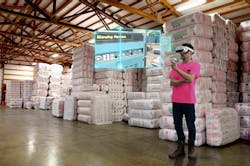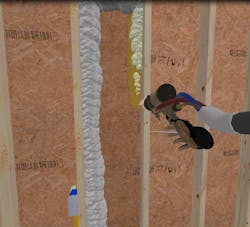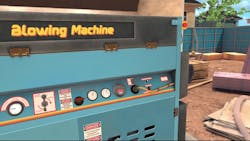Virtual Reality Hits the Jobsite with New Training Program
Could virtual reality be the future of jobsite training? Building product manufacturer Owens Corning is betting on it with its VR training program launch.
The manufacturer says VR training is more effective and less expensive than traditional training on a jobsite or in a classroom. Owens Corning offers video training and a learning management system for its installers but sought a new approach that would speak to the future of skills training.
“We said, ‘[Video] is awesome, but what are we going to do to really put it over the top and make sure that it’s relevant in five, 10 years from now?’” says Marketing & Contactor Training Manager Derek Fowler.
It’s a method of workforce training that’s been growing for nearly a decade. Meta launched Meta for Work (formerly Oculus for Business) back in 2017, used by companies such as DHL, and Walmart. VR is even used to train healthcare professionals through companies like Osso VR and at the Johns Hopkins School of Nursing.
Extended reality—a term used to encompass the use of virtual reality, real environments, and man-machine interactions—company Strivr delivers training to Verizon, Sprouts, MGM Resorts, and Bank of America.
Owens Corning says VR is an impactful tool for construction recruitment, preparation, and employee retention. A survey of 1,000 respondents from consulting company PricewaterhouseCoopers found VR trainees were four times more focused, emotionally connected to the content, and faster to train. In Walmart’s case, employee satisfaction increased by 30%.
Owen Corning’s unique training program, in partnership with VR training provider PIXO, is an option for insulation contractors that provides a VR headset, nine training modules, and a learning management system, costing $2,400 for the first year and $1,800 the following years.
“That entire bundle is for less than the cost of one lost time incident, or one less than the cost of one poorly installed spray foam job,” says Fowler. “You can get people into the headset and have them experience and learn how to prevent and diagnose those things before they happen in real life.”
These interactive virtual training modules cover installation and safety modules, including diagnosing off-ratio foam, fall protection, ladder safety, and more. While employees can install spray insulation, prepare a jobsite, and diagnose challenges without stepping foot on a jobsite, it does not replace real training.
“OSHA doesn’t currently accept VR training as part of their 10 or OSHA 30 certification, but what this does is it really engages people in the safety aspect,” explains Fowler. “Listen, I took the OSHA 30 courses—engaging isn’t how I would describe them. Virtual reality training is engaging, and it gets people excited about training, and so it’s a good supplement to the things that you learn.”



